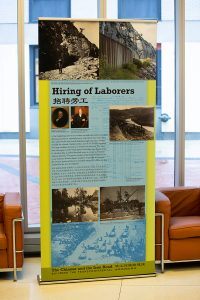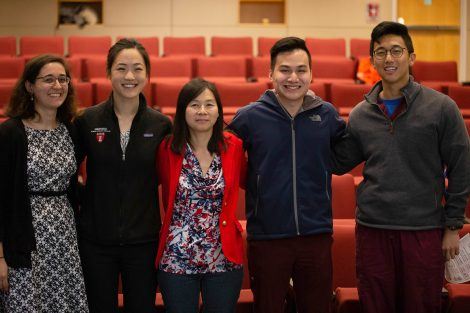May 29, 2019—This month marked the 150th anniversary of the day a golden spike was driven into the ground in Utah to connect the two sides of the Transcontinental Railroad. It was a momentous event that would not have been possible without the backbreaking labor of some 20,000 Chinese workers, but they have long been relegated to the sidelines of this history. Joining in a nationwide effort to highlight these workers’ achievements and sacrifices, members of the Harvard T.H. Chan School of Public Health and Harvard School of Dental Medicine communities recently gathered to mark both the anniversary and Asian Pacific American Heritage Month.
The celebratory events, held May 17 in the Research and Education Building at HSDM, included an exhibition of panels on the history of Chinese workers on the Transcontinental Railroad, in addition to a discussion focused on what it means to be Asian American today. They were organized by the Offices of Diversity and Inclusion at Harvard Chan School and HSDM, and the Association of Harvard Asian and Asian American Faculty and Staff.
During the panel discussion, dental students and HSDM’s Diversity and Inclusion Fellows Quang Do, Daniel Shen, and Nancy Zhu, public health doctoral student Supriya Misra, and Kimberly Truong, director of inclusion programs at Harvard Chan School, spoke about their challenges and sources of pride as Asian Americans. Among the challenges mentioned was the tendency by many in the U.S. to view Asian Americans as a monolithic group, despite their considerable diversity in countries of origin, language, socioeconomic status, and educational interests and attainment.
While some Asian Americans may take pride in being considered a “model minority,” panel moderator Josephine Kim, director of diversity and inclusion at HSDM, said that it is a dangerous myth. “It was a form of propaganda that emerged during the Civil Rights movement,” she said. “It was used as a way to say there’s no discrimination and bias. If there was, this minority group wouldn’t be so successful.” She said, “Asian Americans were used as a wedge to pit people of color groups against each other and for the general population to avoid taking responsibility for systemic racism.” The implication for other people of color, she said, is that if they are not successful, it is their own fault.
Microaggressions against Asian Americans—such as the assumption that someone who looks Asian is not an American—are still common, but panelists were encouraged by the increasing visibility of non-stereotypical Asian Americans in pop culture and literature. “It’s amazing to see how far we’ve come,” Truong said while citing Viet Thanh Nguyen, Thi Bui, and Bao Phi’s works.

Later that day, organizers hosted a Special Tea and viewing party for the Transcontinental Railroad exhibition. The panels told the story of Chinese workers’ contributions to the treacherous western portion of the railroad known as the Central Pacific between 1863 and 1869. Their work took them through the Sierra Nevada mountains and included the Summit Tunnel—which was 1,695 feet long and blasted through solid granite.
Workers endured many hardships, including the ever-present risk of avalanches, blasting accidents, and diseases. On top of this, they faced discriminatory conditions including having to pay for their food and lodging out of their wages, while white workers did not. Following the completion of the railroad, they faced virulent anti-Chinese sentiments that led to passage of the Chinese Exclusion Act, which barred Chinese laborers from immigrating to the U.S. and placed restrictions on those already living here.
Learn more about viewing the exhibition in the Boston area and related events.
Photos: Osa Igiede
